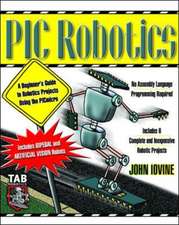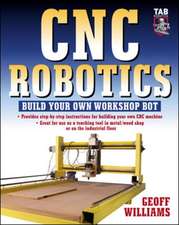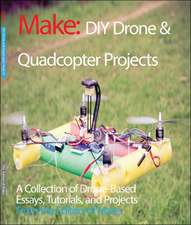Fundamentals of Robot Technology: An Introduction to Industrial Robots, Teleoperators and Robot Vehicles
Editat de D. J. Todden Limba Engleză Paperback – mar 2012
Preț: 581.65 lei
Preț vechi: 684.30 lei
-15% Nou
Puncte Express: 872
Preț estimativ în valută:
111.29€ • 116.21$ • 91.91£
111.29€ • 116.21$ • 91.91£
Carte tipărită la comandă
Livrare economică 15-29 aprilie
Preluare comenzi: 021 569.72.76
Specificații
ISBN-13: 9789401167703
ISBN-10: 9401167702
Pagini: 248
Ilustrații: 244 p.
Dimensiuni: 155 x 235 x 13 mm
Greutate: 0.35 kg
Ediția:Softcover reprint of the original 1st ed. 1986
Editura: SPRINGER NETHERLANDS
Colecția Springer
Locul publicării:Dordrecht, Netherlands
ISBN-10: 9401167702
Pagini: 248
Ilustrații: 244 p.
Dimensiuni: 155 x 235 x 13 mm
Greutate: 0.35 kg
Ediția:Softcover reprint of the original 1st ed. 1986
Editura: SPRINGER NETHERLANDS
Colecția Springer
Locul publicării:Dordrecht, Netherlands
Public țintă
ResearchCuprins
1: Introduction.- Definitions of ‘robot’ and ‘robotics’.- Other definitions in robotics.- Connections between robotics and some related subjects.- Bibliographic notes.- 2: Geometric configurations for robots.- The distinction between arms and vehicles.- Structural elements of manipulators.- Degrees of freedom and number of joints.- Types of joint.- Construction of joints.- Parallel linkages.- Constrained linkages.- Distributed manipulators.- Robot transporters and workpiece positioners.- Arm configuations.- Tension structures.- Wrists.- End effectors (grippers, tools and hands).- Bibliographic notes.- 3: Operation, programming and control of industrial robots.- Types of industrial robot and their methods of operation.- Methods of teaching and programming.- Types of controller and program memory.- Analysis and control.- Programming languages for industrial robots.- Bibliographic notes.- 4: Actuators for robots.- Pneumatic actuation.- Hydraulic actuation.- Hydrostatic circuits.- Electric actuation.- Mechanical transmission methods.- Bibliographic notes.- 5: Sensing for robots.- Joint angle.- Joint angular velocity.- Rectilinear position.- Force and torque.- Proximity sensing and range measurement.- Touch sensing.- Vision.- Types of computer vision.- Non-visual sensing in welding and other processes.- Bibliographic notes.- 6: Performance specifications of industrial robots.- Geometric configuration; number of axes.- Positioning accuracy and repeatability.- Angular accuracy and repeatability.- Speed.- Speed and acceleration accuracy.- Spatial specifications: working volume, swept area, reach.- Payload (maximum load capacity).- Control-related specifications.- Vibration.- Miscellaneous specifications.- Bibliographic notes.- 7: Applications of industrial robots.-Machine loading.- Pallet loading and unloading.- Investment casting.- Spot welding.- Arc welding.- Spraying (paint, enamel, epoxy resin and other coatings).- Fettling (grinding, chiselling); polishing.- Cutting.- Inspection.- Training and education; hobby robots.- Robots in assembly.- New applications for industrial robots.- Integration of industrial robots into the workplace.- Bibliographic notes.- 8: Teleoperated arms.- Methods of control.- Special characteristics of teleoperators.- Applications of teleoperators.- Computer assisted teleoperation.- Bibliographic notes.- 9: Mobile robots.- Land surface robots.- Legged robots.- Robot submersibles.- Robots in air and space.- Bibliographic notes.- 10: Automated guided vehicles.- Automated guided vehicle technology.- Bibliographic notes.- 11: Robotics and artificial intelligence.- Vision.- Voice communication.- Planning.- Modelling.- Adaptive control.- Error monitoring and recovery.- Autonomy and intelligence in robots.- Expert systems in robotics.- Bibliographic notes.- 12: Economic and social aspects of robotics.- Reasons for installing robots.- Economic costs and benefits of installing industrial robots.- Acceptability of industrial robots by the workforce.- Employment.- Other social issues of robotics.- Bibliographic notes.- References and Bibliography.










